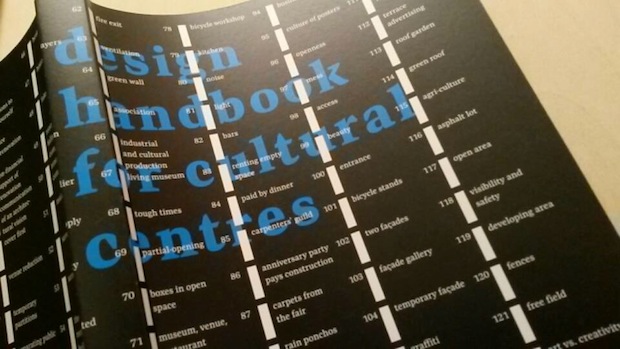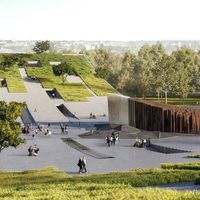Design handbook for cultural centres

Drawing on the experiences of cultural centres across Europe, Stanica Cultural Centre (the Stanica Žilina-Záriečie - culture node) in Zilina, Slovakia has published a design handbook for cultural centres - a book of architecture and design ideas from independent cultural centres in Europe, members of the Trans Europe Halles network.
Stanica describes the process of researching and writing the book:
We have published a book that we had worked on for three years. We sent out architect Peter Lényi to 30 cultural centres of the Trans Europe Halles network and the result is 123 small as well as bigger stories and ideas which you would not find in any architecture or design magazine. The centres operate and act but not aspire to any awards. They might cost few euros and often they were created by a non-graduated author. The book - a collection about the centres - is a document about unused (and unusable) places which turned into cultural centres solely thanks to people and not politicians or public investments with famous architects. It didn’t happen at once, it took years of small steps and small ideas and changes being added and gradually layered.
Peter Lényi travelled to various cultural centres. To large ones such as Melkweg in Amsterdam with an audience of half a million or Village Underground in London hosting big stars. But also to much smaller ones like us, for example, in Žilina or to a swimming videotheque on a river in Riga. His book is primarily about our buildings, old factories, warehouses or shopping spaces revitalised thanks to culture. It is about why we like them and not about their fascinating architecture; it is about small and cheap solutions and their gradual implementation. About utopian ambitions. It is about how we started, got together, how some of us act like squatters and others officially cooperate with cities. Also about how we had to move sometimes. About how we create gardens or green rooftops. And also about how to solve issues with fire escape routes or how to make a bicycle stand out of nothing. About how it is not necessary to renovate everything, how we would not be able to survive without creative management and that we actually have a great advantage over large “brick” institutions. Because for years we lived on the edge and therefore we are able to put together small ideas and build complex units which are working and alive.
The book is an encyclopaedia, a manual and a document and we would like it to serve to all of us who work in independent cultural institutions and create them. We build them and renovate them, often single-handedly. At the same time it will also serve to architects and designers who collaborate with us – in its introduction Peter Lényi writes that he would have liked to know it all before he started to do something for independent culture as an architect.
It is a book which differs from usual architecture and design publications at first sight – it does not have a large format (A5), heavy paper or a price tag that would predestine its place in architecture studio’s shelves. On the contrary, we wanted it to be a guide which you can look into at any time, a book to inspire, to entertain or to make you realize that our colleagues throughout Europe “stick” things together in the same way as we do. The book is in English language, it has 272 colour pages, Peter Liška and Marcel Benčík are behind its graphic design.
You can order the book here. By purchase of this book, you donate money that supports the renovation of new cultural space Nova synagoga / kunsthalle Zilina in Slovakia. We are also happy to send it to you by post.
Stanica Cultural Centre has occupied the old station building of the still operational, Zilina-Zariecie train station since 2003, combining the roles of independent venue, artistic laboratory and activists’ collective. On the white map of today we wish to be a culture node - creative, educative and critical. We continue the story of a small train station, where people stop as they’re passing by, to share news and experiences from their travels.
Similar content
26 Nov 2016
14 Nov 2016
deadline
06 Sep 2023
posted on
22 Dec 2015
posted on
20 Jan 2014





